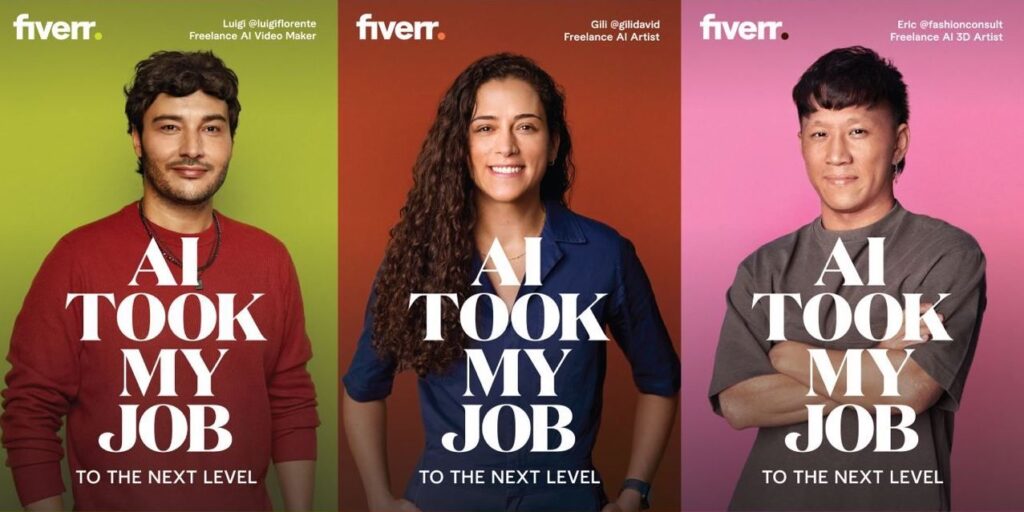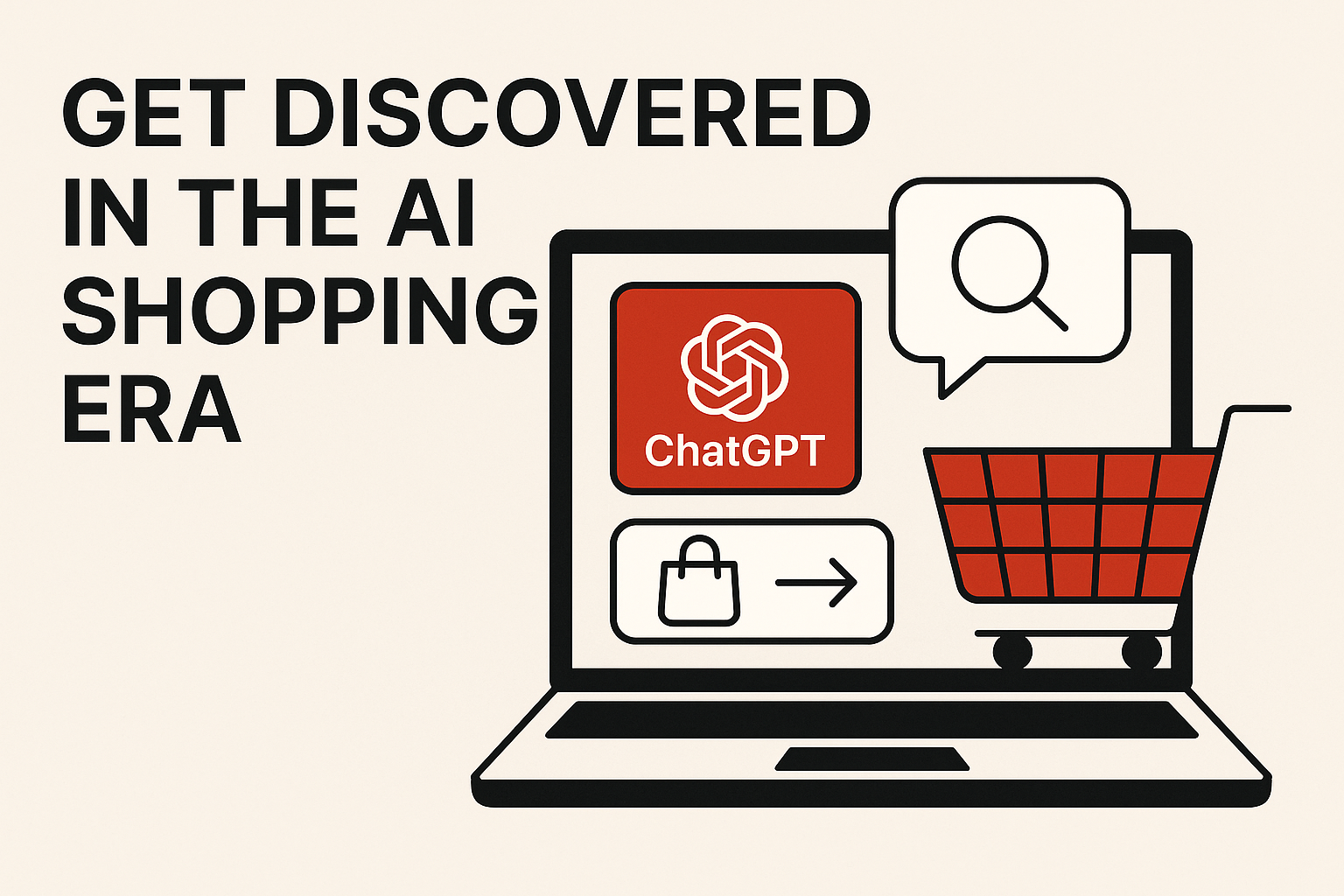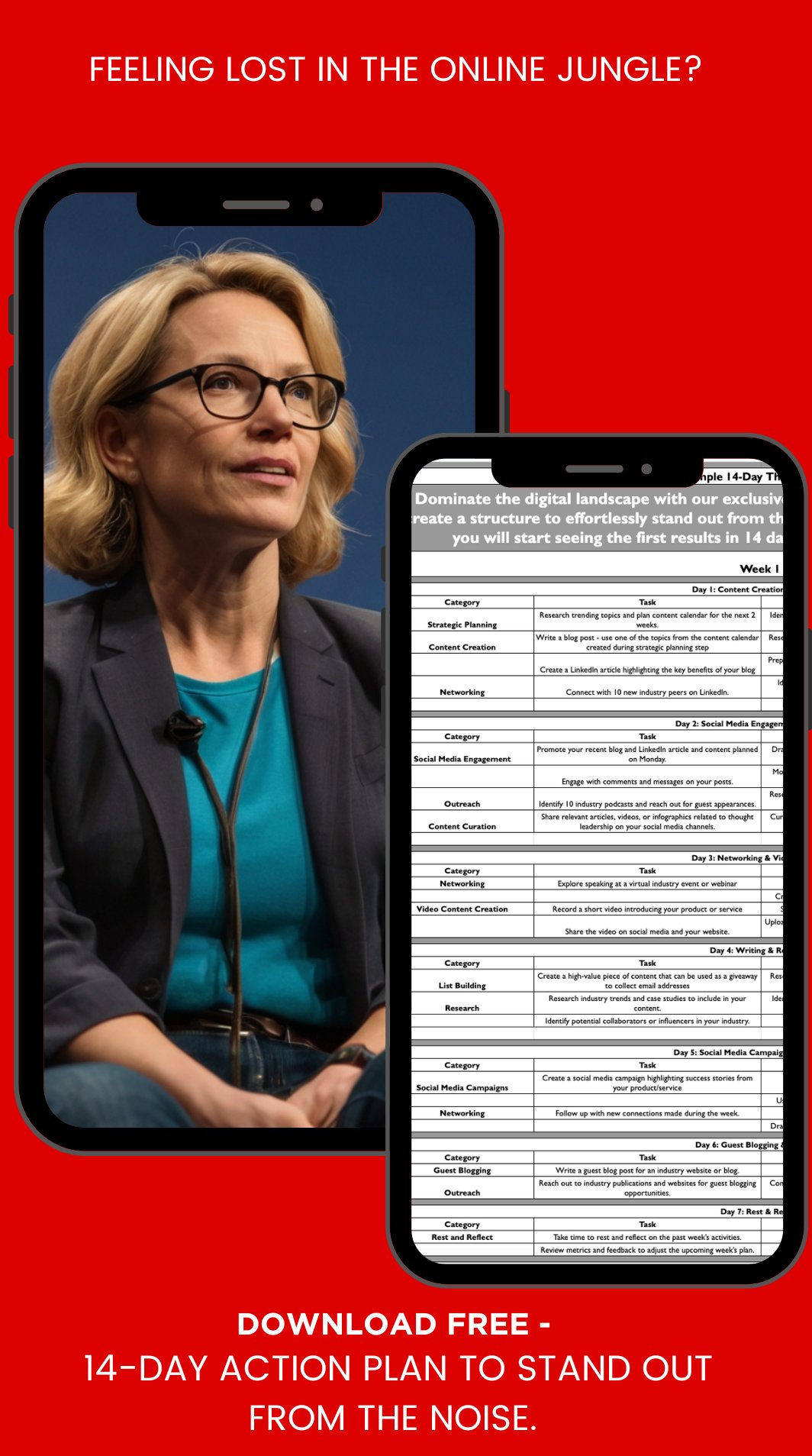Content creation often feels like a necessary evil.
You know it’s crucial for brand visibility, thought leadership, and customer engagement.
But let’s be honest—when you’re juggling investor meetings, product launches, and team scaling, crafting that perfect blog post or social media campaign can fall to the bottom of your priority list.
What if I told you there’s a way to 10x your content output without sacrificing quality or authenticity? Welcome to the AI-powered content revolution.
Table of Contents
ToggleThe AI Advantage: More Than Just Efficiency
Before we dive into the nitty-gritty, let’s address the elephant in the room: Will AI-generated content lack the human touch?
Spoiler alert: Not if you use it right.
AI in content creation is like having a hyper-efficient, always-on brainstorming partner. It doesn’t replace your expertise or vision; it enhances them. Here’s how:
- Idea Generation at Scale: Stuck on what to write about next? AI can analyze trending topics in your industry and suggest relevant angles that resonate with your audience.
- First Draft in Minutes, Not Hours: Remember those days of staring at a blank page? They’re over. AI can create a solid first draft based on your input, giving you a foundation to build upon.
- Personalization at Your Fingertips: Want to tailor your message for different segments of your audience? AI can help you customize content for various personas without starting from scratch each time.
- SEO Optimization Without the Headache: No more guessing games with keywords. AI tools can suggest optimal phrases and help structure your content for maximum search visibility.
- Content Refinement and Editing: Polish your drafts with AI-powered editing tools that go beyond just grammar checks, ensuring your content is engaging and on-brand.
Now that we’ve set the stage, let’s dive into a step-by-step guide on how to leverage AI for content creation without losing your unique voice.
Step 1: Brainstorming with AI – From Blank Page to Brilliant Ideas
Remember the last time you sat down to plan your content calendar and felt… stuck? AI can be your breakthrough moment.
How to Do It:
- Set Clear Objectives: Before you even fire up an AI tool, ask yourself: What’s the endgame? Are you looking to position yourself as a thought leader in blockchain? Drive sign-ups for your new SaaS product? Your objective will guide the AI’s output.
- Choose Your AI Sidekick: Tools like ChatGPT, Gemini, Claude (my personal favorite), or industry-specific AI writing assistants can be your go-to for this stage. Each has its strengths, so experiment to find your perfect match.
- Craft Your Prompt: This is where the magic happens. Be specific. Instead of asking for “blog post ideas,” try something like: “Generate 5 thought-provoking blog post ideas that address the challenges of scaling a B2B SaaS startup in a post-pandemic economy. Focus on topics that would resonate with C-suite executives in the tech industry.”
- Refine and Iterate: Don’t settle for the first output. Use the AI’s suggestions as a springboard for your own ideas. Ask follow-up questions, request variations, or combine different concepts.
Pro Tip: Use AI to identify gaps in your current content strategy. Ask it to analyze your existing posts and suggest topics you haven’t covered that your competitors are talking about.
Step 2: From Outline to First Draft – Letting AI Do the Heavy Lifting
You’ve got your killer idea. Now it’s time to flesh it out. This is where AI can save you hours of time without compromising on quality.
Here’s How:
- Create a Detailed Outline: Use AI to expand on your chosen topic. For example: “Create a detailed outline for a blog post titled ‘The Future of Work: How AI Will Transform Tech Leadership by 2030’. Include main sections, subsections, and key points to cover under each.”
- Generate the First Draft: Once you’re happy with the outline, it’s time to let AI work its magic. Your prompt could look something like this: “Based on the outline we created, write a 1500-word first draft of the blog post. Maintain a conversational yet authoritative tone, include relevant statistics where appropriate, and ensure each section flows logically into the next.”
- Add Your Personal Touch: This is crucial. Once you have the AI-generated draft, go through it and infuse it with your personal experiences, insights, and unique perspective. This is what turns a good post into a great one.
Remember: The goal isn’t to publish the AI’s output verbatim. Use it as a sophisticated first draft that you can then mold and shape with your expertise and personality.
Here are some of the top AI tools in the market (Credit: Jonathan Parsons) – you can practically replace any marketing task with AI.
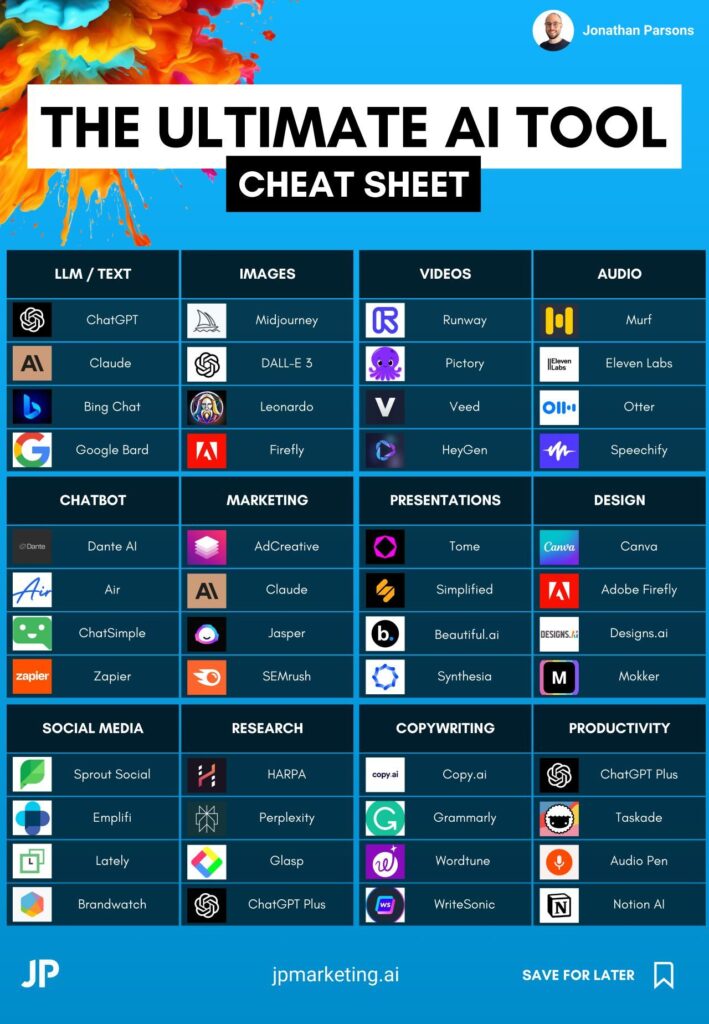
Choose a tool that is well-suited to the type of content you want to write. For example, if you want to write blog posts, you might choose a tool that specializes in long-form content generation.
Step 3: Refining and Editing – Polishing Your AI-Assisted Masterpiece
Now that you have a solid draft, it’s time to elevate it from good to great. AI can help here too, but this is also where your human touch becomes invaluable.
The Process:
- Use AI for Initial Edits: Start with AI-powered editing tools like Grammarly or Hemingway Editor. They’ll catch basic errors and suggest improvements in readability.
- Enhance with AI: Ask your AI writing assistant to improve specific sections. For example: “Rewrite the introduction to make it more engaging and include a compelling statistic about AI adoption in the tech industry.”
- Fact-Check and Verify: While AI is great at generating content, it can sometimes produce inaccuracies. Always verify any facts, statistics, or claims in your content.
- Inject Your Voice: This is where you truly make the content yours. Add anecdotes from your own experience as a tech CEO. Include insights that only someone in your position would have.
- Final Human Edit: Read through the entire piece, ensuring it flows well, maintains your voice, and delivers value to your target audience.
Pro Tip: Read your content out loud. It’s a great way to catch awkward phrasing or areas that don’t sound authentic to your voice.
Expert tip: Go to Google search and look for more questions people search for related to your keywords

Step 4: SEO Optimization – Making Sure Your Brilliance Gets Found
Creating great content is only half the battle. You need to ensure it reaches your target audience. This is where AI-powered SEO tools come into play.
Here’s the Game Plan:
- Keyword Research: Use AI-powered SEO tools like SEMrush or Ahrefs to identify high-value keywords in your niche.
- Content Optimization: Once you have your keywords, use AI to help integrate them naturally into your content. You could use a prompt like: “Optimize this blog post for SEO, focusing on the keyword ‘AI in tech leadership’. Suggest places to naturally incorporate this and related keywords without compromising readability.”
- Meta Descriptions and Titles: AI can generate multiple options for SEO-friendly titles and meta descriptions. You can then choose the one that best fits your style and goals.
- Internal Linking: Ask AI to suggest relevant internal links from your existing content that would add value to this new piece.
Remember: While AI can provide valuable SEO insights, the final decision on what feels right for your brand should always be yours.
Step 5: Content Promotion – Amplifying Your Reach with AI
Creating great content is just the beginning. To truly leverage your efforts, you need a solid promotion strategy. Here’s where AI can give you a significant edge.
The AI-Powered Promotion Playbook:
- Social Media Blitz: Use AI to generate multiple social media posts for different platforms, each highlighting a key aspect of your content. For example: “Create 5 Twitter posts, 3 LinkedIn updates, and 2 Facebook posts to promote my blog article on ‘The Future of Work: How AI Will Transform Tech Leadership by 2030’. Ensure each post is optimized for its specific platform and includes relevant hashtags.”
- Email Marketing: AI can help craft compelling email subject lines and body content to promote your new piece to your subscriber list. Try a prompt like: “Write an engaging email to our tech executive mailing list, highlighting the key insights from our latest blog post on AI and tech leadership. Include a clear call-to-action to read the full article.”
- Personalized Outreach: Use AI to draft personalized outreach messages to industry influencers or potential collaborators who might be interested in your content.
- Content Repurposing: Ask AI to suggest ways to repurpose your blog content into other formats, such as:
- Infographic outlines
- Podcast episode scripts
- Slide deck content for webinars
- Timing Optimization: Leverage AI-powered social media tools to determine the best times to post your content for maximum engagement.
Pro Tip: While AI can generate great promotional content, always review and adjust to ensure it aligns with your brand voice and personal style.
The Future of AI in Content Creation: What Tech CEOs Need to Know
As we look ahead, it’s clear that AI will play an increasingly significant role in content creation and marketing. But fear not—this doesn’t mean human creativity will become obsolete. Instead, we’re entering an era of human-AI collaboration that will unlock new levels of productivity and creativity.
Here’s what to keep on your radar:
- Hyper-Personalization: AI will enable content personalization at a scale we’ve never seen before. Imagine being able to tailor your thought leadership pieces to specific industry verticals or even individual prospects—automatically.
- Predictive Content: AI algorithms will get better at predicting what content will resonate with your audience before you even create it, helping you stay ahead of trends.
- Interactive Content Creation: We’ll see more AI tools that can generate interactive content experiences, like personalized product demos or choose-your-own-adventure style whitepapers.
- Voice and Video: As AI advances, we’ll have more sophisticated tools for generating and editing voice and video content, making multimedia production more accessible to busy executives.
- Ethical Considerations: As AI becomes more prevalent in content creation, there will be growing discussions around disclosure and ethical use. Stay ahead of the curve by being transparent about your AI usage and maintaining a strong human element in your content.
Conclusion: Embracing the AI Content Revolution
As a tech CEO, you’re no stranger to adopting cutting-edge technologies. It’s time to bring that same innovative spirit to your content creation process. AI isn’t just a tool—it’s a strategic advantage that can help you scale your influence, engage your audience more effectively, and free up your time to focus on big-picture leadership.
Remember, the goal isn’t to replace your unique insights and experiences with AI-generated content. Rather, it’s to amplify your voice, extend your reach, and maximize the impact of your thought leadership.
By embracing AI in your content creation process, you’re not just keeping up with the times—you’re positioning yourself at the forefront of a new era of digital communication. And in the fast-paced world of tech leadership, that’s exactly where you need to be.
So, are you ready to revolutionize your content strategy? The future of tech leadership content is here—and it’s powered by the perfect fusion of human expertise and AI capability.
Your move, CEO. The content revolution awaits.
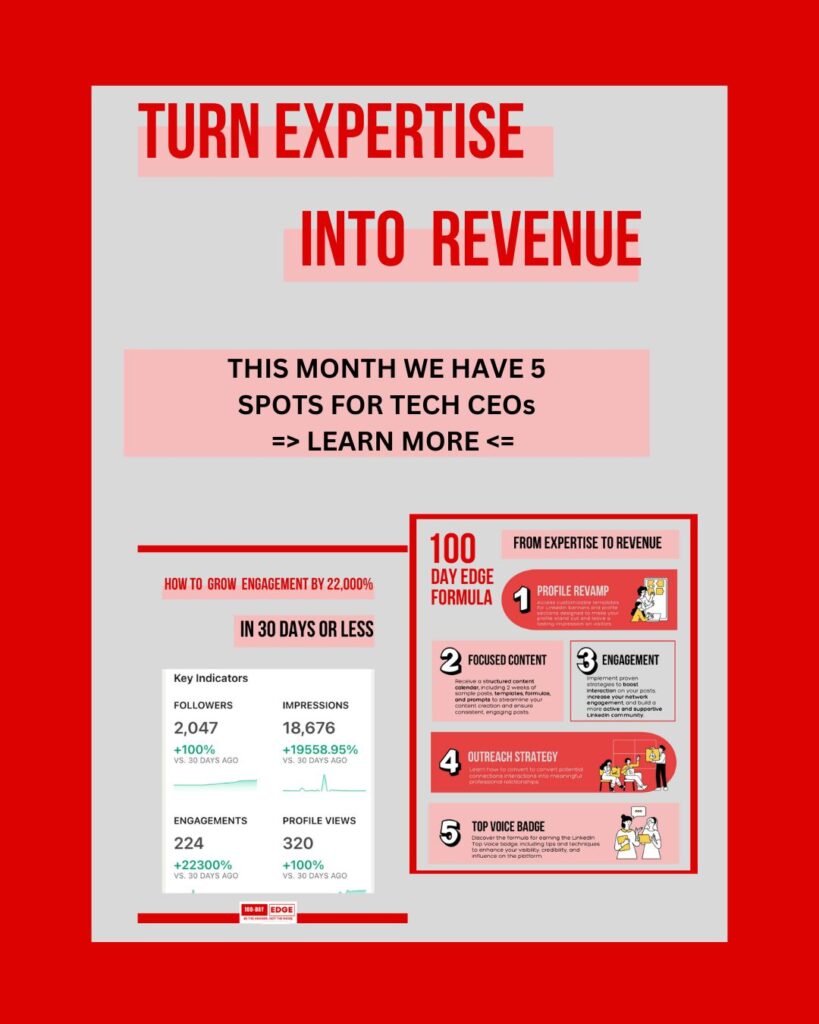
This month, my team is helping 5 technology leaders transform their expertise into tangible business results.
In 100 days, you’ll:
- Stage 1: Define your EDGE and optimize your online presence.
- Stage 2: Engage your tribe and land your first high-value client.
- Stage 3: Set your EDGE on fire with strategic content and recurring revenue.

